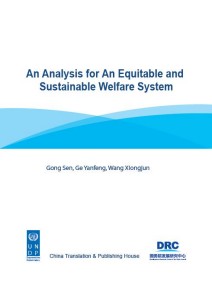An Analysis for An Equitable and Sustainable Welfare System
Mar 16,2016

Authors: Gong Sen, Ge Yanfeng, Wang Xiongjun
Department of Social Development Research,Development Research Center of the State Council
United Nations Development Programme
China Translation & Publishing House
Summary
After more than three decades of development since the introduction of reform and opening up, China has established a social welfare system that has underpinned the country’s economic growth and societal stability. Although the current social welfare system emphasizes universality, scheme designs differ among regions, among professions, and between urban and rural residents. The institutions may be similar, but the service quality, benefits and management agencies vary greatly. Moreover, efforts to narrow the beneficiary gap quite often lead to the increase in benefits of both the less developed regions/groups and the more advanced ones, making the efforts largely ineffective. With the solidifying social stratums, accelerating urbanization and the aging process, as well as the slowdown of China’s economy and fiscal capacity growth, increased frag- mentation renders the traditional approach unsustainable. Establishing new development concepts to tackle these issues, as well as promoting institutional integration and social welfare system sustainable development has become not only a significant re- search area, but also a top government priority.
This report focuses on several selected public service and social security programmes that are closely related to China’s current socio-economic development and are given priority in policy considerations. These include compulsory education, health care, old-age pension and social assistance.
For PDF of the full article, please click here.














